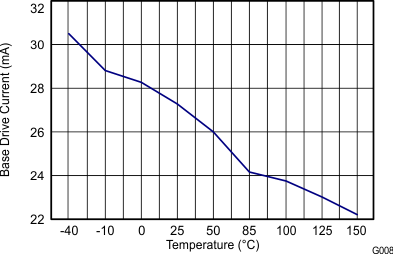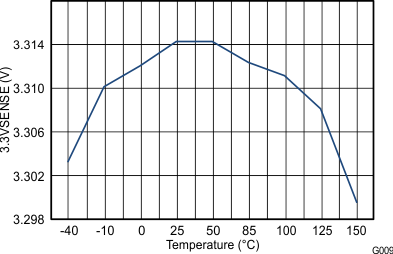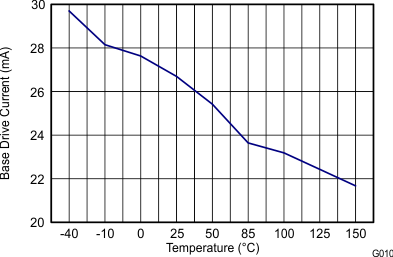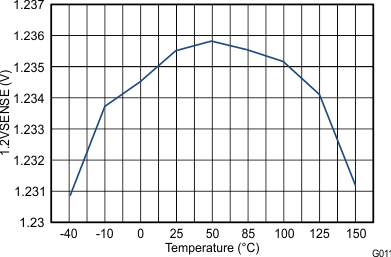SLVSBB6F March 2012 – July 2015 TPS65300-Q1
PRODUCTION DATA.
- 1 Features
- 2 Applications
- 3 Description
- 4 Revision History
- 5 Pin Configuration and Functions
-
6 Specifications
- 6.1 Absolute Maximum Ratings
- 6.2 ESD Ratings
- 6.3 Recommended Operating Conditions
- 6.4 Thermal Information
- 6.5 DC Characteristics
- 6.6 Timing Requirements
- 6.7 Switching Characteristics
- 6.8 Typical Characteristics
- 6.9 5-V Linear Regulator (5VO)
- 6.10 3.3-V Linear Regulator Controller (3.3VO)
- 6.11 1.234-V Linear Regulator Controller (1.2VO)
- 7 Detailed Description
-
8 Application and Implementation
- 8.1 Application Information
- 8.2
Typical Application
- 8.2.1 Design Requirements
- 8.2.2 Detailed Design Procedure
- 8.2.3 Application Curves
- 9 Power Supply Recommendations
- 10Layout
- 11Device and Documentation Support
- 12Mechanical, Packaging, and Orderable Information
Package Options
Mechanical Data (Package|Pins)
Thermal pad, mechanical data (Package|Pins)
- PWP|24
Orderable Information
6 Specifications
6.1 Absolute Maximum Ratings
over operating free-air temperature range (unless otherwise noted)(1)| MIN | MAX | UNIT | ||
|---|---|---|---|---|
| Buck regulator | VIN, VIN_D | –0.3 | 45 | V |
| BOOT | –0.3 | 50 | V | |
| PH | –1 –2 for 30 ns |
45 | V | |
| VSENSE | –0.3 | 5.5 | V | |
| Control | IGN_EN | –0.3 | 45 | V |
| EN, 3.3VSENSE, 1.2VSENSE, RT/CLK, VREG | –0.3 | 5.5 | V | |
| Output | 3.3VDRIVE, 1.2VDRIVE | –0.3 | 8 | V |
| nRST, IGN_ST | –0.3 | 5.5 | V | |
| DELAY, COMP | –0.3 | 7 | V | |
| BOOT_LDO, 5V | –0.3 | 9 | V | |
| Operating junction temperature, TJ | –40 | 150 | °C | |
| Storage temperature, TstgMoved the storage temperature and ESD ratings out of the Absolute Maximum Ratings table and into the new Handling Ratings table | –55 | 165 | °C | |
(1) Stresses beyond those listed under Absolute Maximum Ratings may cause permanent damage to the device. These are stress ratings only, and functional operation of the device at these or any other conditions beyond those indicated under Recommended Operating Conditions is not implied. Exposure to absolute-maximum-rated conditions for extended periods may affect device reliability.
6.2 ESD Ratings
| VALUE | UNIT | ||||
|---|---|---|---|---|---|
| V(ESD) | Electrostatic discharge | Human-body model (HBM), per AEC Q100-002(1) | ±2000 | V | |
| Charged-device model (CDM), per AEC Q100-011 | All pins | ±500 | |||
| Corner pins (1, 12, 13, and 24) | ±750 | ||||
(1) AEC Q100-002 indicates that HBM stressing shall be in accordance with the ANSI/ESDA/JEDEC JS-001 specification.
6.3 Recommended Operating Conditions
over operating free-air temperature range (unless otherwise noted)| MIN | NOM | MAX | UNIT | ||
|---|---|---|---|---|---|
| VIN, VIN_D | 5.6 | 40 | V | ||
| BOOT | 5.6 | 48 | V | ||
| PH | –1 | 40 | V | ||
| IGN_EN | 0 | 40 | V | ||
| EN, VSENSE, 3.3VSENSE, 1.2VSENSE, RT/CLK, nRST, IGN_ST | 0 | 5.25 | V | ||
| VREG, 3.3VDRIVE, 1.2VDRIVE | 0 | 7.5 | V | ||
| SS, DELAY, COMP | 0 | 6.5 | V | ||
| BOOT_LDO | 0 | 8.1 | V | ||
| Operating ambient temperature range, TA | –40 | 125 | °C | ||
6.4 Thermal Information
| THERMAL METRIC(1) | TPS65300-Q1 | UNIT | ||
|---|---|---|---|---|
| PWP (HTSSOP) | RHF (VQFN) | |||
| 24 PINS | 24 PINS | |||
| RθJA | Junction-to-ambient thermal resistance | 33.6 | 30.3 | °C/W |
| RθJC(top) | Junction-to-case (top) thermal resistance | 16.6 | 30.5 | °C/W |
| RθJB | Junction-to-board thermal resistance | 14.5 | 8.7 | °C/W |
| ψJT | Junction-to-top characterization parameter | 0.4 | 0.3 | °C/W |
| ψJB | Junction-to-board characterization parameter | 14.3 | 8.8 | °C/W |
| RθJC(bot) | Junction-to-case (bottom) thermal resistance | 1.3 | 1.6 | °C/W |
(1) For more information about traditional and new thermal metrics, see the Semiconductor and IC Package Thermal Metrics application report, SPRA953.
6.5 DC Characteristics
VIN = 6 V to 27 V, IGN_EN = VIN, TJ-Max = 150°C, unless otherwise noted6.6 Timing Requirements
| MIN | NOM | MAX | UNIT | |||
|---|---|---|---|---|---|---|
| Switch-Mode Output 5.3 V | ||||||
| tON-min | Minimum ON time | 40 | ns | |||
| Dmax | Maximum duty cycle | 97% | ||||
6.7 Switching Characteristics
VIN = 6 V to 27 V, IGN_EN = VIN, TJ-Max = 150°C, unless otherwise noted| PARAMETER | TEST CONDITIONS | MIN | TYP | MAX | UNIT | |
|---|---|---|---|---|---|---|
| 5V (5-V Linear Regulator) | ||||||
| Vsoft-start | Soft start on enable cycle | 5VO = 0 V (initially) with fsw = 2.5 MHz | 13 | ms | ||
| 3.3-V Linear Regulator Controller (3.3VSENSE) | ||||||
| tss | Soft-start time | 3.3VO = 0 V (initially) with fsw = 2.5 MHz | 12.3 | ms | ||
| 1.2-V Linear Regulator Controller (1.2VSENSE) | ||||||
| tss | Soft-start time | 1.2VO = 0 V (initially) with fsw= 2.5 MHz | 8.5 | ms | ||
| nRST (Reset Indicator) | ||||||
| tnRSTdly | Filter time | Delay before nRST is asserted low | 11 | µs | ||
| RT/CLK (Oscillator Setting of External Clock Input) | ||||||
| fsw | Switching freq using RT mode | 2 | 3 | MHz | ||
| Switching freq using CLK mode | 2 | 3 | MHz | |||
| Minimum clock input pulse duration | 40 | ns | ||||
| Internal oscillator frequency | Switching frequency tolerance for clock | –14% | 14% | |||
| External clock input | Switching frequency tolerance for clock | –20% | 10% | |||
6.8 Typical Characteristics
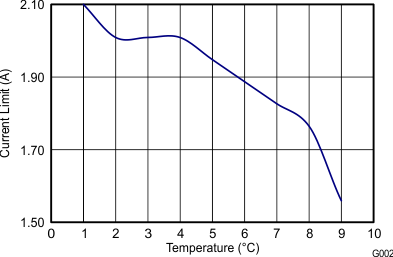
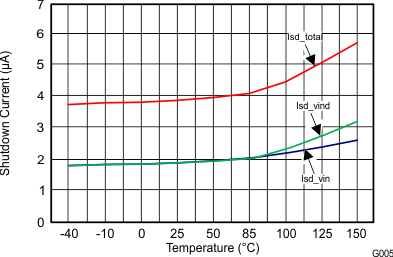
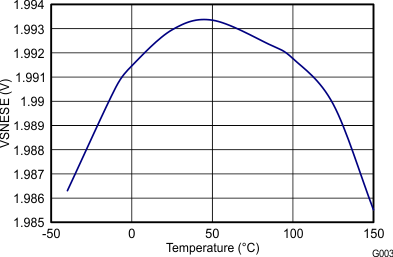
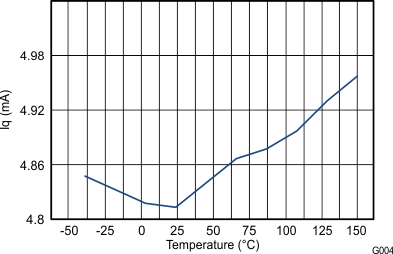
6.9 5-V Linear Regulator (5VO)
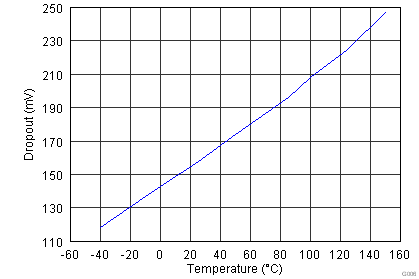
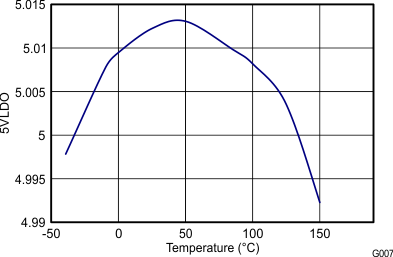
6.10 3.3-V Linear Regulator Controller (3.3VO)
